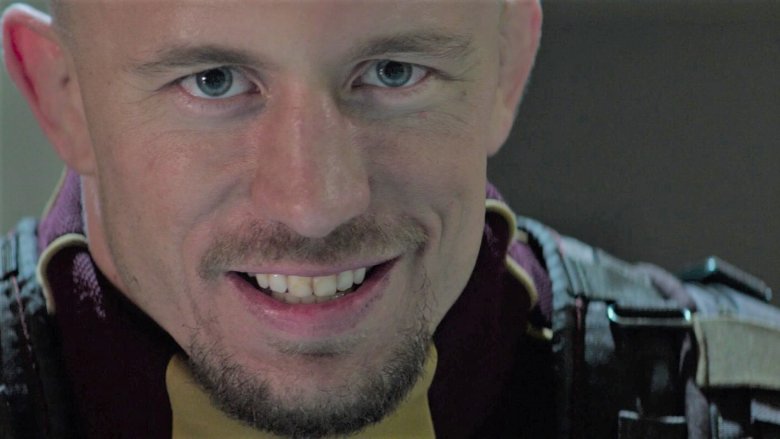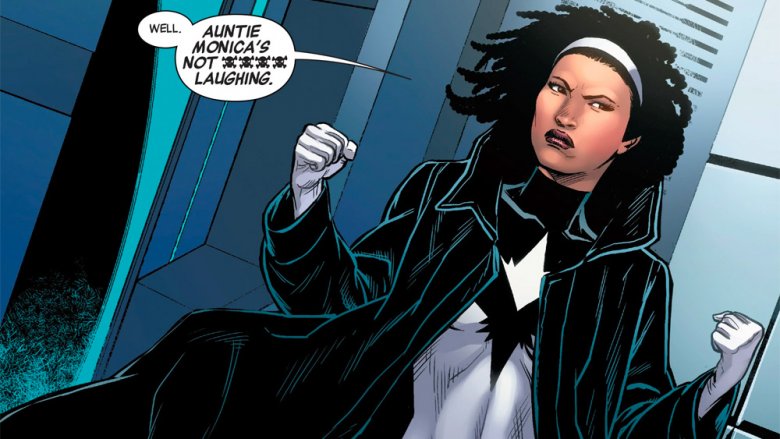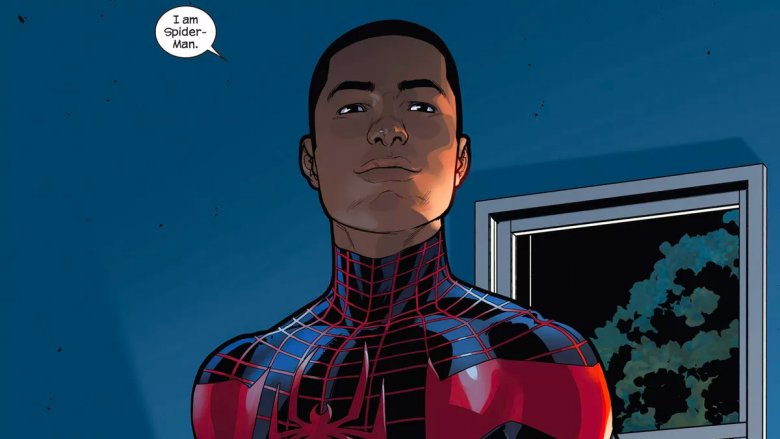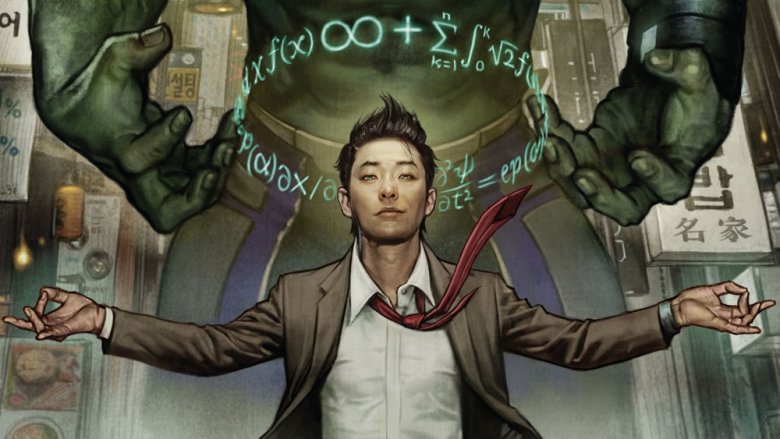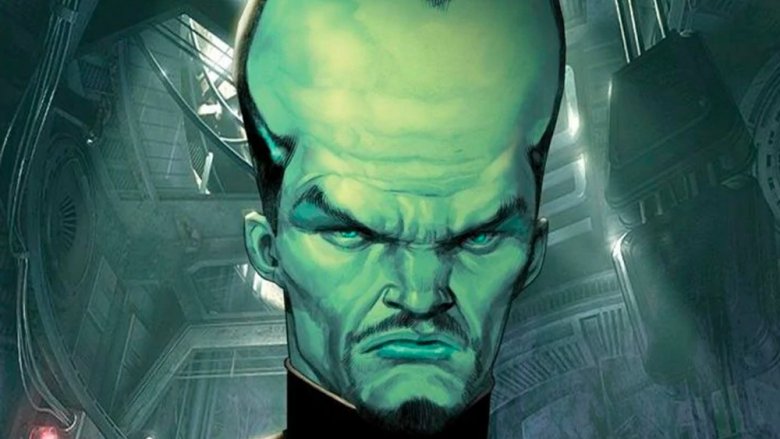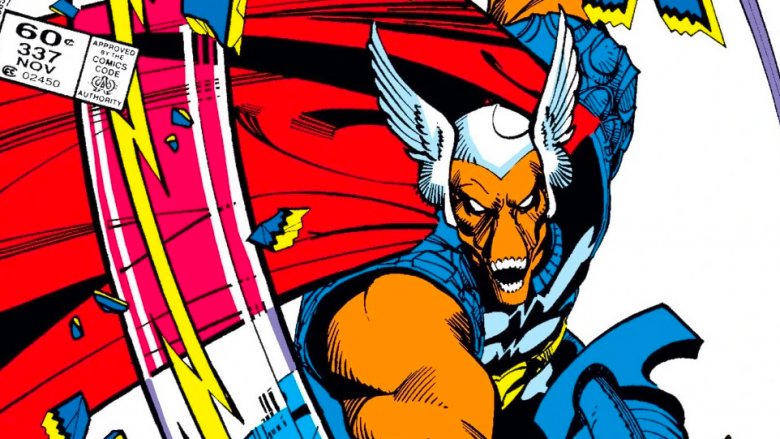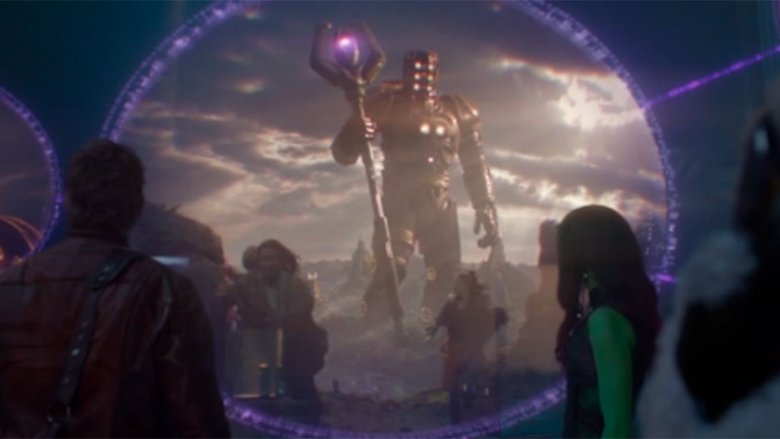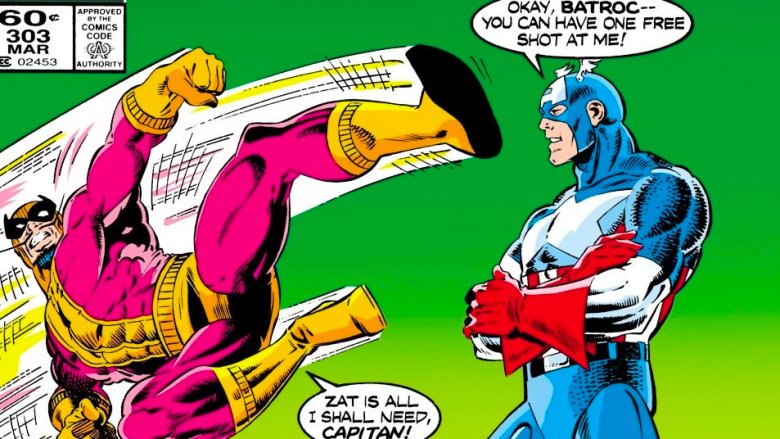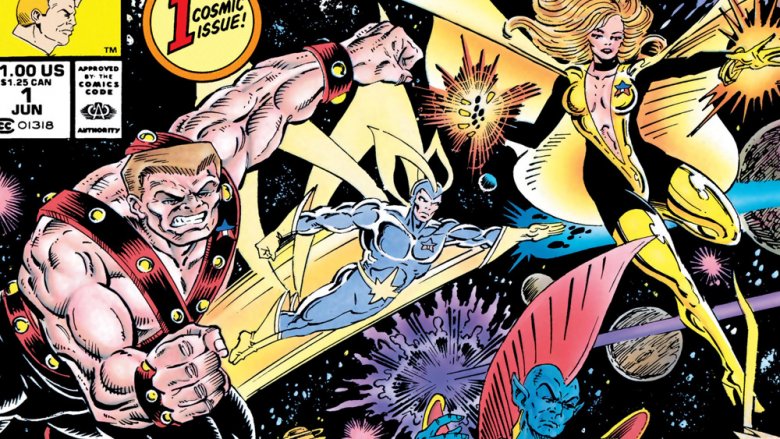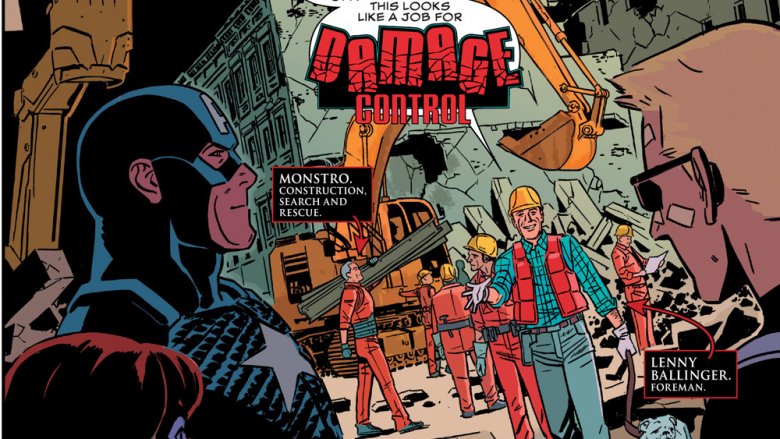Characters You Didn't Know Already Existed In The MCU
Saying that there are a lot of characters in the Marvel Cinematic Universe is sort of like saying that the Hulk is "pretty strong." It's technically accurate, but it doesn't really capture the scope of what we're dealing with here. With two dozen movies in its first phase and more on the way, the MCU is packed full of superheroes, supervillains, and supporting characters. The thing is, even if you can rattle off the names of every hero who showed up to slug it out with Thanos at the climax of Avengers: Endgame, you still might not have them all.
While they're not the ones who get their names in the titles, there are plenty of slightly more obscure characters hiding in Easter eggs throughout the MCU. From secret villains to the characters who just might make up the next generation of heroes, here are the characters you didn't know already existed in the Marvel Cinematic Universe.
Spectrum shows up in Captain Marvel
While she was certainly the first one to make it to the big screen, Carol Danvers is definitely not the first superhero on Marvel's roster to use the codename "Captain Marvel." In fact, she's not even the first female character to use the name. That honor goes to Monica Rambeau, who was the second person to operate as a hero under that title.
Originally created in 1982 by Roger Stern and John Romita Jr., Monica — and this might sound a little familiar — was exposed to a strange alien energy that gave her the ability to manipulate, and even transform herself into, any form of radiation. She took the name Captain Marvel since, unlike most other superheroic "Captains," she was actually a captain in the New Orleans Harbor Patrol, and ended up leading the Avengers. Eventually, she changed her codename several times, bouncing around to Photon and Pulsar and even just going by "Monica" for a while, until settling on her current codename, Spectrum.
If you've seen Captain Marvel, you've already seen Monica, even if she was pretty far from being the superhero that we know from the comics. Instead, she appears as the young daughter of Carol's best friend and subtextual gal pal, Maria Rambeau, who uses the callsign "Photon" as a fighter jet pilot. With the rest of the films taking place 25 years after Carol's first return to Earth back in the '90s, there's plenty of opportunity for an adult Monica to show up in the present-day MCU to help Carol deal with the problems of the very big universe that she's been charged with protecting. And hey, considering that no one ever actually refers to Carol as "Captain Marvel" in that movie, maybe the title was referring to Monica all along!
Miles Morales has already been mentioned in the MCU
Thanks to his starring role in Spider-Man: Into the Spider-Verse, moviegoing audiences are already familiar with Miles Morales. What they might not realize, however, is that even though he never appeared onscreen, Miles exists in the MCU, too.
One of the most memorable scenes in Spider-Man: Homecoming comes when Spidey attempts to use his high-tech suit's "enhanced interrogation mode" on an extremely unimpressed criminal played by Donald Glover, and ends up in a debate over where you can find the best sandwich in Queens. The thing is, Glover's character is identified by his criminal record as Aaron Davis, a name that sharp-eyed fans will recognize as the Prowler.
After the Great Sandwich Debate, Davis agrees to help Spider-Man bust up the Vulture's arms deal because, as he says, "I don't want those weapons in this neighborhood, I got a nephew who lives here," and Aaron Davis' nephew, of course, is young Miles Morales. Ultimately, that's going to be pretty bad news for Davis — Spider-uncles don't tend to make it out of their nephews' origin stories alive — but it does mean that the MCU potentially has another Spider-Man waiting in the wings. Still no sign of Gwen Stacy, though.
Amadeus Cho is indirectly referenced in Age of Ultron
This familial connection is a little more tenuous than the one that leads us to Miles Morales existing in the MCU, but in its own way, it might actually be more interesting. Plus, it's way easier to miss. In Avengers: Age of Ultron, there's a Korean scientist named Helen Cho who winds up being forced to help Ultron build his fancy new body. As you might expect, she's not a character created for the movie. She actually comes from the comics. The only thing is, on the page, we never actually see her alive.
Instead, comics readers have been following the adventures of her son, Amadeus Cho, since 2005, where he debuted as an extremely reimagined version of a very obscure Golden Age character named Mastermind Excello. In this case, young Amadeus was targeted by sinister forces who wanted to use his considerable intelligence for themselves, and he went on the run after his family — including his mother, geneticist Helen Cho — was murdered.
Amadeus is a super-genius in his own right, and he's been called the eighth smartest person in the Marvel Universe, which might not seem like much until you remember that he shares a world with Reed Richards, Tony Stark, and Victor von Doom, a dude who invented time travel in his basement. He also has had a string of weird adventures and identities throughout the comics. He was the sidekick for the literal Greek god Hercules for a while, which led to him becoming the Olympian "Prince of Power," and he even spent some time as the Totally Awesome Hulk.
So it makes sense that the Marvel films would want to have a character in place who could step in as the new Hulk if Mark Ruffalo ever left the role, considering that we're already at the point where a few of the founding Avengers have departed the franchise. Unfortunately for Amadeus fans, as of Endgame, the Hulk is mostly CGI, and really just requires Mark Ruffalo to show up and do some intense voice acting. Still, if Bruce Banner ever gets his own solo film again, Amadeus could fill the role of a super-intelligent sidekick pretty easily, with way more going for him than Rick Jones ever had.
The Leader appears in The Incredible Hulk
Speaking of the possibilities of the Hulk getting another shot at his own film, there was a time back when that seemed like an inevitability. The second film in the MCU — the one that nobody remembers happening between Iron Man and Iron Man 2 — was The Incredible Hulk, and like all superhero movies for the past few decades, it seemed like it was setting things up for a franchise.
Obviously, that never happened. Incredible Hulk proved to be, well, forgettable, and when Mark Ruffalo took over the role from Edward Norton in The Avengers, it turned out that the MCU Hulk worked much better as a member of the team than he did on his own. That said, all of those pieces for the unseen Hulk franchise are still out there, and while Thunderbolt Ross managed to show back up in a few films, there's a major Marvel villain with his origin story already taken care of.
The big fight in Incredible Hulk goes down between the Hulk and the Abomination (a slightly less incredible Hulk), but a piece of the plot revolves around aspiring scientist Samuel Sterns (Tim Blake Nelson). At the end of the film, he's dosed himself up with gamma radiation and grows himself a giant head. If you're up on your Hulk lore, you'll know that this is the origin of one of Bruce Banner's longest-running nemeses, the Leader, whose hulked-out brain makes him as smart as the big guy is strong. With everything wrapped up with most of our existing villains, it might be time for a comeback. But on the other hand, it's been nine years since we've had to think about that guy, so maybe he's just working at Subway.
Beta Ray Bill has a strange cameo in Thor: Ragnarok
In 1983, legendary comics creator Walt Simonson kicked off a truly definitive run on Thor in what might be the most surprising way possible: He introduced a brand new version of the god of thunder and left the old one stranded on Earth. The weirdest part? The new Thor was Beta Ray Bill, an alien who looked like a humanoid space-horse, a change that was so big that it kicked off with Bill straight-up shattering the logo that had been in use since the '60s on the cover of his first appearance, which wound up being a permanent change.
Eventually, everything would wind up working out for the best. Thor (the guy) wound up regaining the power of Thor (the god), but Bill was so good-hearted and honorable that Odin granted him his own indestructible magic hammer. Now, he and Thor consider themselves to be best friends and "oath brothers" who have each others' backs whenever cosmic and/or mythological forces are too big for just one Thor.
Obviously, the MCU's Thor has never been replaced by a space horse, as his weird transformations tend to be more in the "dealing with trauma by stress eating" area than the "Loki turned me into a frog" stuff that you get in the comics. If you keep your eyes open during Thor: Ragnarok, however, you can spot a reference to both Bill's existence and his incredible prowess in combat. On Sakaar, there's a brief glimpse of a statue of the Hulk that's under construction, honoring his status as the Grandmaster's champion. It's placed above two other statues, presumably representing previous champions, and one of them is unmistakably the equine face of Beta Ray Bill.
Oh, and the other one? That's an obscure Hulk villain named the Bi-Beast — so-called because he has two faces stacked on top of each other — who stands as the most unexpected cameo in the entire MCU.
The Celestials have existed in the MCU for a long time
Of all the movies in the upcoming Phase 4 of the MCU, The Eternals is definitely the most unexpected. After all, they've never really been Marvel's most popular group and they have a mythological sci-f flavor that hasn't been captured with any other Marvel movie. So launching them into their own franchise film is somehow even more unexpected than making a couple of big-budget blockbusters about Ant-Man.
You can't say they haven't laid the groundwork, though. While Ikaris and his buddies have their name on the cover, the most enduring contribution to the Marvel Universe to spring from the pages of the Eternals comic wasn't the Eternals themselves. Instead, it was the Celestials, the "space gods" responsible for creating life across the universe as part of a grand interplanetary experiment ... and who occasionally arrive to clean up their planetary petri dishes by destroying entire worlds. Unlike the comics, however, the MCU didn't wait to introduce the Celestials in an Eternals project. Instead, they've been hovering in the background of the MCU for years.
Not one but two Celestials show up in Guardians of the Galaxy, assuming you count the dead ones, but you can be forgiven for missing them. The first one, after all, is more of a location than a character. The seedy space station of Knowhere earned its pun name by being built from the head of a dead Celestial, which should give you an idea of the physical scale we're dealing with here. The second, however, can be seen when the Collector explains the nature of the Infinity Stones to the Guardians. As he does so, we can see the unmistakable Jack Kirby design of one of the space-gods — presumably Exitar the Exterminator, given what it's doing — destroying the population of an entire planet using the Power Stone. In 2012, that was a fun easter egg, but with The Eternals on the horizon, who knows if it means a whole lot more?
Batroc the Leaper has thrown some kicks at Captain America
When you get right down to it, the MCU's Captain America didn't really get a lot out of Cap's extensive roster of foes. Sure, he battled the Red Skull and Hydra, but most of his time has been spent slugging it out with his own friends until he was ready to go toe-to-toe with Thanos. That's a shame, too, because Cap has some great lower-tier bad guys who could add a lot to the MCU, and only a couple of them have been used. One, of course, was Crossbones, aka Brock Rumlow, who got absolutely wrecked in an elevator in The Winter Soldier before being blown up in Civil War. The other, of course, is Batroc the Leaper.
Yeah, that's right. MCU Cap fought Batroc the Leaper in exactly as many movies as he fought the Red Skull ... and it was kind of perfect. In what might actually be the MCU's best example of typecasting, the French martial arts master/mercenary was played by French-Canadian UFC champion Georges St-Pierre in a brief fight at the beginning of Winter Soldier that, like most Cap vs. Batroc fights, ended with Captain America punching Batroc through a wall.
Still, it's nice to know that he's out there, and with Steve Rogers passing the Cap identity down to Sam Wilson at the end of Endgame, it would be nice to see how Sam handles some of Captain America's most famous villains. Plus, maybe this time, GSP could deliver a few lines instead of fighting in silence. Zee only thing bettair zan la premiere fight would be to 'ear Batroc's tres ridicule accent in le cinema, non?
The original Guardians of the Galaxy have shown up alongside Star-Lord
While they have the strongest claim to the name these days, the Guardians of the Galaxy team that Star-Lord leads in the MCU weren't the first team to go by that name in the comics ... at least, not in our real-world timeline. Sure, after getting together during the Annihilation event in 2005, they were the first team of Guardians in the Marvel Universe, but the Guardians team adventuring in the distant future of the 31st century first appeared on the page back in 1969, and they had a long-running comic in the early '90s.
Obviously, the team we see in the MCU reached a much bigger level of fame by a pretty huge margin, but it's easy to argue that without that original team, Star-Lord would still be the forgotten character who made one obscure appearance in 1976. That's why it's nice that the 31st-century Guardians made their own appearance in the MCU. Sort of.
At the end of Guardians of the Galaxy Vol. 2, when the Ravagers all gather for Yondu's celebratory fireworks funeral, you can spot present-day versions of the original Guardians in their crew: the crystalline Martinex, the extremely thick Charlie-27, an uncredited Miley Cyrus as Mainframe, and even two different versions of Starhawk, played by Sylvester Stallone and Michelle Yeoh. That makes sense, given that Yondu himself was also a product of that original roster, albeit in a very different form than the redneck space pirate we see in the film, and it stands to reason that these characters might just wind up forming a team of their own at some point. Of course, it's unlikely that they'll be palling around with a 31st-century version of Captain America rocking a sweet '90s bandanna/sleeveless trench coat combo, but the chances of that happening aren't really any slimmer than seeing Rocket Raccoon in the biggest movie of all time.
Damage Control has already cleaned up the MCU
In the opening moments of Spider-Man: Homecoming, the Vulture gets his criminal motivation when the government's "Department of Damage Control" shows up to kick him out of the extremely lucrative salvage job of cleaning up after an alien invasion. However, actress Tyne Daly isn't just playing a faceless bureaucrat, and the "Department of Damage Control" isn't just a blunt name for what they're doing.
While they've only been used sparingly over the years, Marvel fans will undoubtedly recognize the reference to Damage Control, a team created by Dwayne McDuffie and Ernie Colón. The basic idea is that they're the answer to the question of why New York City can suffer an alien invasion, a Hulk rampage, or an attack by Atlantis and then look perfectly normal when the next month's issue comes out. They're a team of super-powered construction workers and logistics experts that were gathered together by Ann Hoag — Daly's character in Homecoming — along with Tony Stark and the Kingpin, Wilson Fisk, two very rich men with very good reasons to keep the city functioning as normal.
While the Damage Control comics have always been based around a sitcom-style tone with a few satirical jabs at how the world of superheroes works, the cast has expanded over the years to include a whole roster of interesting characters. There's the fearless bill collector Albert Clearly, who once delivered an invoice to Doctor Doom. And then there's Tom Foster, the size-changing nephew of Bill Foster, Laurence Fishburne's character from Ant-Man and the Wasp. And of course, we can't forget about the steam shovel possessed by an alien intelligence named Trull the Unhuman. There's enough there to make a whole series of films all about Damage Control itself! A sort of ... "D.C." Cinematic Universe, if you will.
Nah, that'd never work.
